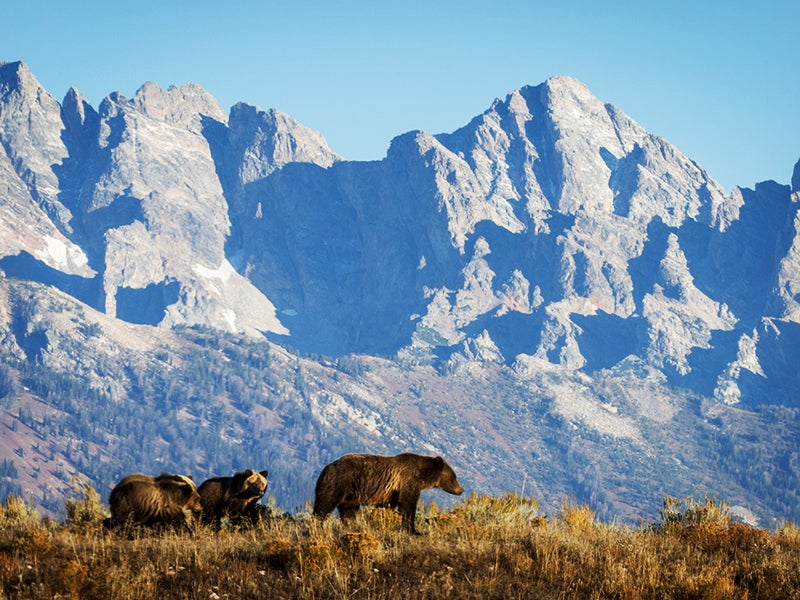Why the Killing of Four Grizzlies Matters
A federal court recently ruled that the killing of four grizzlies in Grand Teton National Park violated the Endangered Species Act, but there’s much work remaining to ensure that the great grizzly will continue to roam our nation’s wildest lands.

This page was published 9 years ago. Find the latest on Earthjustice’s work.
Early in the morning on Thanksgiving Day in 2012, a father and two sons ventured out for an elk hunt in Grand Teton National Park. Trekking softly through the woods around 7:25 a.m., the trio encountered a 534-pound grizzly bear, which may have been feeding on a nearby elk carcass. During the ensuing confrontation, the hunters raised their rifles and fired at the grizzly, killing it.
Since grizzlies are federally protected under the Endangered Species Act, it’s a crime to kill them. And hunting wildlife isn’t normally allowed in national parks, treasured spaces set aside specifically for the protection of America’s natural resources and wildlife. But Grand Teton routinely opens its gates to hunters as part of an “elk reduction” program devised by the National Park Service and the Wyoming Fish & Game Commission.
The hunters were cleared after an investigation determined the outcome had been unavoidable. But the following year, the National Park Service and the U.S. Fish & Wildlife Service authorized the lethal “taking” of four more grizzlies in Grand Teton, under the expectation that similar future conflicts would arise during elk hunts.
Earthjustice, on behalf of the Sierra Club, the Western Watersheds Project and the Center for Biological Diversity, sued the federal agencies for allowing more grizzly bear killings, arguing that they had failed to take a “big picture” look at the overall impact of this decision.
The killing of these four grizzlies, when added to the other grizzly “takings” previously authorized by government biologists around the Yellowstone region, would have tripled the amount of grizzly bear mortality that is considered to be sustainable. Such an outcome would only have worsened a disturbing trend. Grizzly bear deaths have been on the rise due to meat-related conflicts with humans, since the bears have become more reliant on meat as a primary food source.
On March 29, 2016, in a victory for grizzlies and conservationists alike, a federal court ruled that the agencies had indeed violated the Endangered Species Act in authorizing the killings. It was an important win, but Yellowstone grizzlies still face catastrophic losses of two primary food sources, in part as a result of climate change. Wildlife biologists believe this has caused the bears to adapt by turning to elk meat as a substitute.
Wyoming operates 22 elk feeding grounds, where the oft-targeted animals are supplied with winter handouts of hay and pellets, a practice that bolsters their numbers for the benefit of hunters.
Unfortunately, clustering at these sites has caused more elk to contract diseases like hoof rot and scabies. The animals could also face exposure to lethal chronic wasting disease—the elk version of mad cow disease—which is steadily advancing north and west across Wyoming toward the feeding areas.
Meanwhile, Grand Teton’s “elk reduction” program only increases the chances that hunters will cross paths with hungry grizzlies scavenging for meat. Grizzly bear deaths stemming from meat-related conflicts with humans are on the rise, according to wildlife biologist and grizzly bear expert David Mattson.
In the past, grizzlies also relied heavily on fish and seeds—but rapid environmental changes, in some cases linked to climate change, have eliminated these options. Cutthroat trout, a staple for the bears, have all but disappeared from many traditional spawning streams in the Yellowstone ecosystem due to the introduction of an invasive trout species.
And whitebark pines, which produce seeds that deliver energy-bar like packets of nutrients for Yellowstone grizzlies, have been decimated in recent years by a combination of pests and fungus. A mountain pine beetle epidemic, worsened by the effects of climate change, killed most mature whitebark pines in the ecosystem.
The trees were also impacted by fungus and drought conditions.
Grizzlies in the lower 48 once numbered around 100,000. But from the mid-1800s to the mid-1900s, they were pushed to the brink of extinction as a result of hunting and habitat loss. Listed as a “threatened” species under the Endangered Species Act in 1975, they’ve made a significant comeback— but their numbers have remained flat over the last decade. An estimated 600 to 700 grizzlies now live in and around Yellowstone National Park.
Meanwhile, a recent proposal to delist grizzly bears from federal protection means the iconic bears could be made even more vulnerable. The U.S. Fish and Wildlife Service announced in early March that it would propose delisting Yellowstone grizzlies from the Endangered Species Act, which would remove federal protections for the bears and transfer management to the state agencies in Idaho, Wyoming and Montana. Earthjustice is looking hard at the government’s delisting rule, with an eye toward ensuring that the Greater Yellowstone Ecosystem’s grizzly bears have the legal and management protections they need to survive and recover.
The recent court victory on “takings” in Grand Teton will help Yellowstone grizzlies, but there’s much work yet to be done to ensure that the great grizzly will continue to roam our nation’s wildest lands.